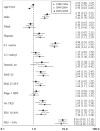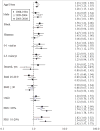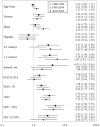Uncontrolled and apparent treatment resistant hypertension in the United States, 1988 to 2008
- PMID: 21824920
- PMCID: PMC3210066
- DOI: 10.1161/CIRCULATIONAHA.111.030189
Uncontrolled and apparent treatment resistant hypertension in the United States, 1988 to 2008
Abstract
Background: Despite progress, many hypertensive patients remain uncontrolled. Defining characteristics of uncontrolled hypertensives may facilitate efforts to improve blood pressure control.
Methods and results: Subjects included 13,375 hypertensive adults from National Health and Nutrition Examination Surveys (NHANESs) subdivided into 1988 to 1994, 1999 to 2004, and 2005 to 2008. Uncontrolled hypertension was defined as blood pressure ≥140/≥90 mm Hg and apparent treatment-resistant hypertension (aTRH) when subjects reported taking ≥3 antihypertensive medications. Framingham 10-year coronary risk was calculated. Multivariable logistic regression was used to identify clinical characteristics associated with untreated, treated uncontrolled on 1 to 2 blood pressure medications, and aTRH across all 3 survey periods. More than half of uncontrolled hypertensives were untreated across surveys, including 52.2% in 2005 to 2008. Clinical factors linked with untreated hypertension included male sex, infrequent healthcare visits (0 to 1 per year), body mass index <25 kg/m2, absence of chronic kidney disease, and Framingham 10-year coronary risk <10% (P<0.01). Most treated uncontrolled patients reported taking 1 to 2 blood pressure medications, a proxy for therapeutic inertia. This group was older, had higher Framingham 10-year coronary risk than patients controlled on 1 to 2 medications (P<0.01), and comprised 34.4% of all uncontrolled and 72.0% of treated uncontrolled patients in 2005 to 2008. We found that aTRH increased from 15.9% (1998-2004) to 28.0% (2005-2008) of treated patients (P<0.001). Clinical characteristics associated with aTRH included ≥4 visits per year, obesity, chronic kidney disease, and Framingham 10-year coronary risk >20% (P<0.01).
Conclusion: Untreated, undertreated, and aTRH patients have consistent characteristics that could inform strategies to improve blood pressure control by decreasing untreated hypertension, reducing therapeutic inertia in undertreated patients, and enhancing therapeutic efficiency in aTRH.
Conflict of interest statement
Yumin Zhao. None
R. Neal Axon. None
Walter A. Brzezinski: None
Keith C. Ferdinand: Speakers’ Bureau at AstraZeneca (<$10,000), Novartis (<$10,000), Forest (<$10,000), and Daiichi-Sankyo (<$10,000); honoraria from AstraZeneca (>$10,000), Novartis (>$10,000), Forest (>$10,000); Consultant/Advisory Board AstraZeneca (<$10,000), Novartis (<$10,000), and Forest (<$10,000).
Figures






Comment in
-
NHANES data highlight the clinical characteristics of those with poorly controlled hypertension.J Clin Hypertens (Greenwich). 2012 Apr;14(4):267-8. doi: 10.1111/j.1751-7176.2012.00596.x. Epub 2012 Mar 6. J Clin Hypertens (Greenwich). 2012. PMID: 22458751 Free PMC article. No abstract available.
References
-
- Hajjar I, Kotchen TA. Trends in prevalence, awareness, treatment and control of hypertension in the United States, 1988–2000. JAMA. 2003;290:199–206. - PubMed
-
- Egan BM, Zhao Y, Axon RN. US trends in prevalence, awareness, treatment, and control of hypertension, 1988–2008. JAMA. 2010;303:2043–2050. - PubMed
-
- U.S. Census Bureau. Statistical Abstract of the United States: 2011. http://www.census.gov/compendia/statb/2011/tables/11s0007.pdf.
-
- Okonofua EC, Simpson K, Jesri A, Rehman S, Durkalski V, Egan BM. Therapeutic inertia is an impediment to achieving the Healthy People 2010 blood pressure control goals. Hypertension. 2006;47:1–7. - PubMed
Publication types
MeSH terms
Substances
Grants and funding
LinkOut - more resources
Full Text Sources
Other Literature Sources
Medical

